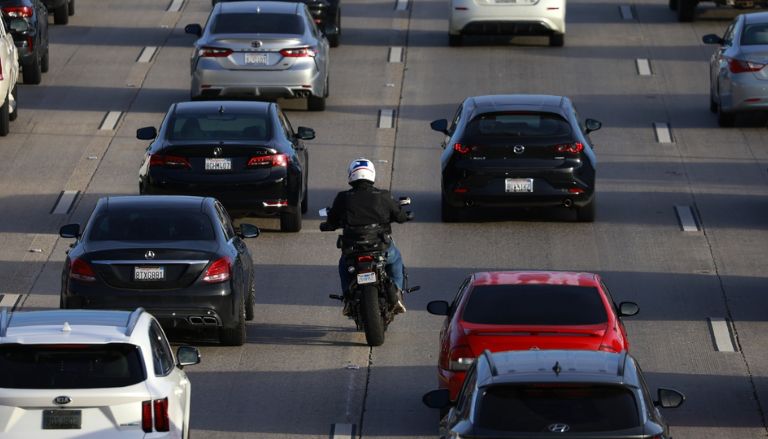As of 2025, the practice of lane splitting—where motorcyclists maneuver between lanes of slow-moving or stationary traffic—remains a contentious issue in Delaware. While some studies suggest potential safety benefits under specific conditions, Delaware law does not explicitly permit lane splitting, leading to legal ambiguities and safety concerns among both motorcyclists and motorists.
Legal Status of Lane Splitting in Delaware
Delaware’s traffic laws do not provide clear guidelines regarding lane splitting (Delaware Code). This absence of explicit legislation means that while lane splitting isn’t expressly prohibited, it’s not officially sanctioned either. This legal gray area can lead to varied interpretations by law enforcement and the judiciary, potentially resulting in citations for reckless driving or unsafe lane changes for motorcyclists who engage in the practice.
In contrast, California remains the only U.S. state with laws explicitly allowing lane splitting (California DMV). The lack of similar legislation in Delaware means motorcyclists must exercise caution, as engaging in lane splitting could lead to legal repercussions.
Safety Considerations and Studies
Research into the safety of lane splitting offers insights that could inform future legislative decisions. A notable study by the University of California, Berkeley analyzed nearly 6,000 motorcycle-involved traffic collisions between June 2012 and August 2013 (UC Berkeley Study). The study found that lane splitting can be relatively safe under specific conditions:
- Speed Conditions: Lane splitting is safer when traffic is moving at 50 mph or less, and motorcyclists do not exceed the speed of surrounding vehicles by more than 15 mph.
- Injury Rates: Motorcyclists who engaged in lane splitting were less likely to suffer head injuries (9% vs. 17%), torso injuries (19% vs. 29%), and fatal injuries (1.2% vs. 3%) compared to those who did not lane split.
- Rear-End Collisions: Lane-splitting riders were significantly less likely to be rear-ended than non-lane-splitting riders (2.6% vs. 4.6%).
These findings suggest that, under controlled conditions, lane splitting may reduce certain risks associated with motorcycling. However, it’s essential to consider that these studies are based on data from regions where lane splitting is legally recognized and regulated, such as California. The applicability of these findings to Delaware, where the practice lacks legal acknowledgment and regulatory frameworks, remains uncertain.
Delaware’s Motorcycle Safety Initiatives
The Delaware Department of Transportation (DelDOT) emphasizes motorcycle safety through various programs and legislative measures. The Delaware Strategic Highway Safety Plan highlights that motorcyclists account for 13% of all traffic fatalities and 12% of serious injuries from 2015 to 2019 (DelDOT Motorcycle Safety). To address these concerns, Delaware has implemented initiatives such as:
- Helmet and Eye Protection Laws: As per Delaware law, all motorcyclists up to 19 years of age must wear a safety helmet and eye protection (Delaware Helmet Law). Additionally, newly endorsed riders—those who have obtained their motorcycle endorsement within the past two years—are required to wear helmets and eye protection, regardless of age.
- “Share the Road” Campaigns: DelDOT has launched public awareness campaigns to promote mutual respect and understanding between motorists and motorcyclists (Share the Road Campaign). These initiatives aim to reduce accidents by educating all road users about safe driving practices and the unique challenges faced by motorcyclists.
The Path Forward
The debate over lane splitting in Delaware involves balancing potential safety benefits with legal and practical considerations. Advocates argue that, when performed responsibly, lane splitting can reduce traffic congestion and decrease the likelihood of rear-end collisions. Critics, however, express concerns about the potential for increased accidents due to driver unawareness and the current lack of legal guidelines.
For Delaware to consider legalizing and regulating lane splitting, several steps would be necessary:
- Comprehensive Research: Conducting state-specific studies to assess the potential impact of lane splitting on traffic safety and flow within Delaware’s unique roadway environments.
- Legislative Action: Develop clear laws that define acceptable practices for lane splitting, including speed limits and conditions under which it can be performed safely.
- Public Education: Implementing educational campaigns to inform both motorcyclists and motorists about new regulations and safe practices associated with lane splitting.
- Law Enforcement Training: Providing training for law enforcement officers to ensure consistent and fair application of any new lane-splitting laws.
Until such measures are considered and potentially enacted, motorcyclists in Delaware are advised to adhere to existing traffic laws and prioritize safety. Engaging in lane splitting without explicit legal authorization may not only result in legal consequences but could also increase the risk of accidents in an environment where other road users are not accustomed to the practice.
For more information on motorcycle safety and regulations in Delaware, individuals can refer to the Delaware Department of Transportation’s official resources (DelDOT Motorcycle Safety).






Leave a Comment